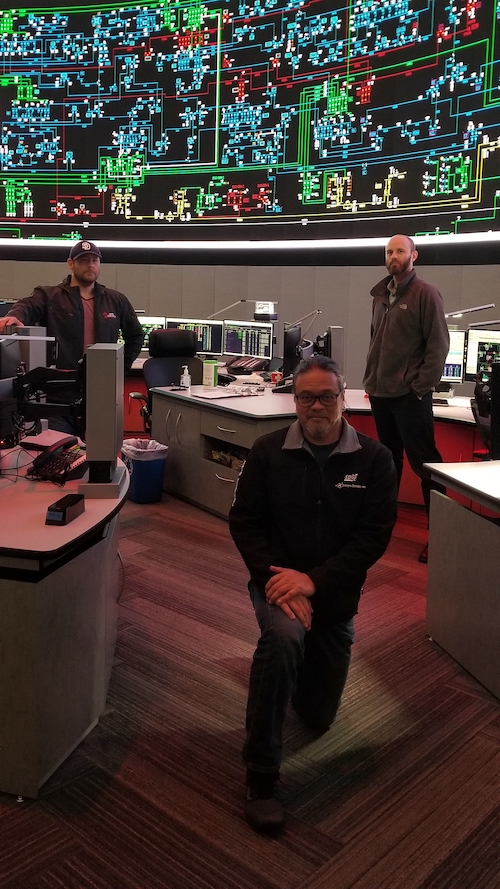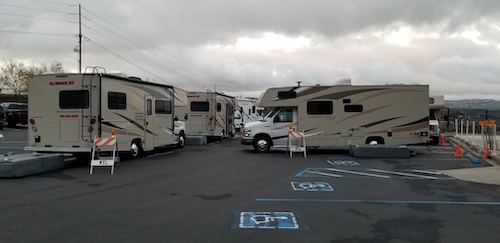Several dozen IBEW utility members have been sequestered at their work sites in California and New York since early April to protect critical power infrastructure and personnel from the threat of COVID-19.

|
| Transmission system operators like San Diego Local 465 members Chris Sullivan, Al Lagunero and Lead Steward Blain Adams-Denner are highly skilled and few in number. Since early April, they have been living and working San Diego Gas & Electric property to protect them from exposure to the novel coronavirus.
|
The IBEW has also signed agreements with dozens more utility companies across the U.S. and Canada, setting the terms for housing the men and women who operate the power grid and run generation plants onsite for shifts lasting as long as four weeks.
“There are some jobs that are essential and can be done from home, some that are essential and can’t, and then there are some jobs that are so specialized, the number of people who can do them so limited, and their job duties so crucial, that they need special protection,” said Utility Department Director Donnie Colston.
It is not the first-time utility workers have sheltered in place. Only so many people can run nuclear or hydroelectric plants or coordinate the operations of the power grid. When hurricanes hit the Gulf Coast, or fires threaten to limit access to hydro plants hidden in the mountains of Northern California, provisions have been made for IBEW members to stay on site for a limited time until the crisis has passed.
In some ways the pandemic is just another natural disaster where the power must stay on and the safest place for the people who can do that is right next to machines.
The workers currently sequestered in New York come from Syracuse Local 97, Johnson City Local 10, Niagara Falls Local 2104 and Massena Local 2032, said Third District International Representative Julie Cosenza.
They are control center operators, distribution and transmission operators regional control operators and dispatchers for National Grid, New York Power Authority and New York State Electric and Gas. Some groups will work and live on site for two weeks. In other locations, the agreement is for four. When the term is up, they are replaced by a second crew. There are no layoffs.
For San Diego Local 465 members lead shop steward Blain Adams-Denner, Christopher Sullivan and Al Lagunero, their 14-day shift began April 6. They work alternating 12-hour shifts and will be replaced April 20th by another three-person crew.
All three volunteered, said Business Manager Nate Fairman, a difficult decision for each of them, but Lagunero explained his decision to volunteer simply.
“I feel this is my best contribution to my community,” he said.
Sullivan said he raised his hand because “our community is depending on continuity of electrical service.”
Fairman said their negotiations with the company about pay and living circumstances were a “marathon” but in the end they agreed on a deal that takes care of the workers and pays them fairly for the time they are away from family and home.
“In times like this, more than ever, we need to stand together in solidarity to ensure our rights are protected” Adams-Denner said.
Another Local 465 employer, the Imperial Irrigation District also brought in RVs, but has not sequestered any workers yet, Fairman said.
“Everyone working to keep us safe and healthy right now has our thanks,” Fairman said. “These sisters and brothers absolutely deserve the title of first responder. Just like our IBEW linemen restoring power to millions after a storm, this story highlights clearly that system operators make similar sacrifices and deserve the recognition they are getting.”

|
| SDG&E brought in RVs for the men to live in while on their 14-day shift. Utilities in New York have also sequestered system operators as well as power generation workers at hydroelectric stations.
|
Colston said similar memoranda of understanding are being negotiated by locals in nearly every IBEW district, and because there is no federal mandate or format in either the U.S. or Canada, their contents vary. For example, Fourth District International Representative Ted Robison worked with a local that negotiated a 21-day sequestration at the utility’s request.
The local and the utility negotiate the MOU, which lays out wage rates, work rules, living conditions and what else is covered by the company – food and laundry, for example. For most, the shift lengths are the normal workday, but not everywhere. And, like nearly everything else, that is subject to further change and negotiation.
“It’s only New York and California, but the words ‘so far’ need to be added to nearly every sentence,” Colston said. “Every day brings a new challenge, and every day our members handle it like professionals. We know how important our jobs are for our customers at home, at work and in hospitals. We take great pride in that.”